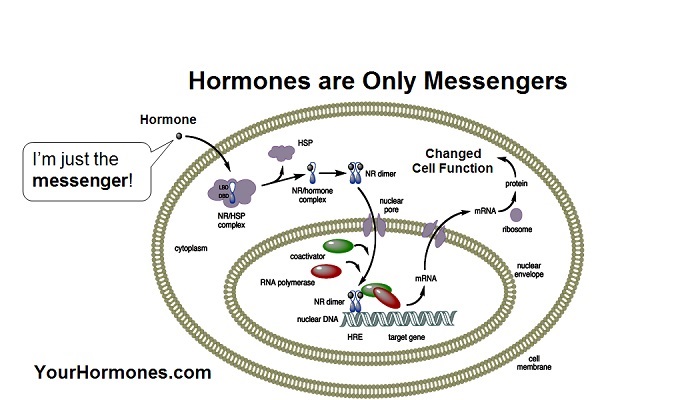Hormones are Only Messengers

Years ago, when I was giving a lecture to other healthcare professionals, I got a look of shock and disbelief when I proclaimed; “Your hormones do not do anything!” That statement came as surprise to the audience, especially since they knew my history with hormones.
But the truth remains: Hormones do not do anything. They do not build neurotransmitters. They do not build muscle proteins. They do not build immunoglobulins. They do not build lipids or phospholipids, proteins or fats. In fact, they do not build anything. They do not transmit nerve impulses, or transport oxygen, or help remove waste from the body. Hormones are not directly involved in performing the physiological functions that we require for life.
Your hormones are messengers. Your hormones instruct every cell, every tissue, every organ, and every system of the body. As messengers, your hormones instruct other cells to DO the work of building neurotransmitters, and other proteins, and lipids, and phospholipids, and every other physiological function that we require for life.
Since hormones only transmit a message to the cells of the body, then hormone replacement is dependent on the ability of the cells to receive the message, and the ability of the cells to respond to the message. The hormones message is a signal that gives directions for the cell to respond to. The process of how cells listen to these signals is referred to as “cell signaling”.
Cell signaling is part of a complex system of communication that governs the basic activities of cells and coordinates cell actions. The ability of cells to perceive and correctly respond to the signals is critical for growth and development, tissue repair, and immunity as well as normal homeostasis in every tissue.
Realizing that hormones are only messengers involved in cell signaling, we can now understand why some people have symptoms of low hormones, even when their lab tests show that their hormone levels are normal. When hormone levels are adequate, but the cells do not receive the signal, it called hormone resistance
The most well-known form of hormone resistance is insulin resistance.
In insulin resistance, muscle, fat, and liver cells do not respond properly to insulin and thus cannot easily absorb glucose from the bloodstream. As a result, the body needs higher levels of insulin to help glucose enter cells. High insulin levels with insulin resistance is prediabetes, and results in type 2 diabetes if not corrected.
Essential fatty acids can improve cell signaling by increasing cell membrane fluidity so the cells can receive the signal better. Nutrients can provide the cell with the cofactors it needs to respond to the signal.
In the membrane theory of diabetes, saturated fatty acid for the diet are deemed responsible for rigid cellular membranes that in turn impair insulin signaling. For hormones to work, their message must be heard by the cell and acted upon by the cell. A meta-analysis showed that taking omega-3 oils for six weeks significantly improved insulin resistance in women, but not in men.[1] However, another study showed that linoleic acid specifically decreased insulin resistance in both men and women.[2] While more research is needed, there is some indication that essential fatty acids and nutrients play a direct role in improving hormonal cell signaling.
Regarding cell response, cell signaling specific to insulin resistance was improved by 160 mcg of Chromium a day and 200 mg of magnesium a day in both genders.[3]
Specific herbals (phytotherapeutics) also can enhance the cell signal for specific hormones. We have been talking about and using “phytoestrogens” for decades, and recognize that certain plant extracts can mimic some of the actions of estrogen. Going beyond that basic understanding, we now realize that specific herbs can affect thyroid hormone receptors, while other herbs affect testosterone, or progesterone or insulin receptors. These herbs directly improve hormone function by improving cell signaling. The role of plants in cell signaling specifically for enhancing hormone function is presented in a summary I wrote on phytotherapeutics.
Using plants to improve hormone function by improving cell signaling is essential when we see people who still have hormone deficiency symptoms even though their hormone levels are within normal range in all their hormone tests. It is also interesting to observe that people who are getting excellent Bioidentical Hormone Replacement Therapy (BHRT) still have deficiency symptoms, even when they have excellent lab results. Those people respond very well to the Hormone Specific™ Formulations that were developed specifically to improve hormone function.
References:
[1] Abbott KA, Burrows TL, Thota RN, Acharya S, Garg ML. Do
ω-3 PUFAs affect insulin resistance in a sex-specific manner? A systematic
review and meta-analysis of randomized controlled trials. Am J Clin Nutr. 2016 Nov;104(5):1470-1484.
PubMed PMID: 27680989.
[2] Belury MA, Cole RM, Bailey BE, Ke JY, Andridge RR,
Kiecolt-Glaser JK. Erythrocyte linoleic acid, but not oleic acid, is associated
with improvements in body composition in men and women. Mol Nutr Food Res. 2016
May;60(5):1206-12. doi: 10.1002/mnfr.201500744. PubMed PMID: 26923704
[3] Dou M, Ma Y, Ma AG, Han L, Song MM, Wang YG, Yao MX, Sun
XF, Li Y, Gao S, Zhang Y. Combined chromium and magnesium decreases insulin
resistance more effectively than either alone. Asia Pac J Clin Nutr. 2016
Dec;25(4):747-753. doi: 10.6133/apjcn.092015.48. PubMed PMID: 27702717.
